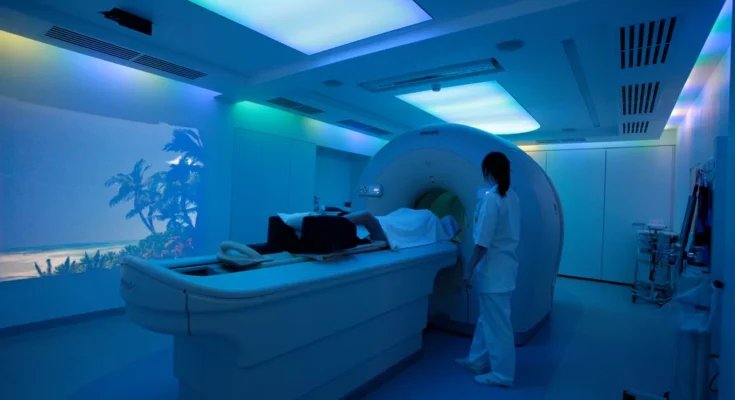In 2021, the market for Nuclear Imaging Equipment worldwide was worth $2.7 billion US dollars. AMR Group projects that the market will reach US$ 4.8 billion by 2031, growing at a CAGR of 5.6 percent between 2022 and 2031.
Industry Overview
Nuclear imaging equipment is used to visualize and analyze the function and structure of organs and tissues within the body using radioactive substances. These machines use small amounts of radioactive material, called radiopharmaceuticals or radiotracers, which are injected, inhaled, or swallowed by the patient. The radiopharmaceuticals then emit gamma rays, which are detected by the nuclear imaging equipment to create detailed images of the internal organs and tissues.
There are various types of nuclear imaging equipment, including: Single-Photon Emission Computed Tomography (SPECT) scanners: SPECT scanners use gamma cameras to detect the radioactive substances emitted by the radiopharmaceuticals. The images produced by SPECT scanners can show the function and structure of organs and tissues, and are used in diagnosing a range of conditions such as cancer, heart disease, and neurological disorders.
Get Free Exclusive PDF Sample Copy of This Research: https://analyticsmarketresearch.com/sample-request/nuclear-imaging-equipment-market/14510/
Positron Emission Tomography (PET) scanners: PET scanners use a combination of radiotracers and detectors to create detailed images of the body’s metabolic activity. PET scanners are often used in diagnosing cancer, heart disease, and neurological disorders.
Hybrid imaging systems: Hybrid imaging systems, such as PET/CT and SPECT/CT scanners, combine the functional information from PET or SPECT imaging with the anatomical information from CT scans to provide more precise and detailed images. Nuclear imaging equipment is widely used in the field of medical imaging, and is an essential tool for diagnosing and monitoring a range of diseases and conditions.
Market Dynamics
The nuclear imaging equipment market is influenced by various factors, including: Increasing prevalence of chronic diseases: The rising prevalence of chronic diseases, such as cancer, cardiovascular disease, and neurological disorders, is driving the demand for nuclear imaging equipment. These machines play a vital role in the diagnosis, treatment planning, and monitoring of these conditions.
Technological advancements: Advancements in nuclear imaging technology, such as the development of hybrid imaging systems, are improving the accuracy and reliability of nuclear imaging equipment. This is expected to boost demand for nuclear imaging equipment in the coming years.
Growing demand for personalized medicine: The trend towards personalized medicine, which involves tailoring medical treatment to the individual characteristics of the patient, is driving demand for nuclear imaging equipment. These machines can provide detailed information on an individual’s disease status and response to treatment, enabling healthcare professionals to develop personalized treatment plans.
Increasing healthcare expenditure: Rising healthcare expenditure, particularly in developing economies, is driving the growth of the nuclear imaging equipment market. Governments and private organizations are investing in healthcare infrastructure and technologies to improve access to quality healthcare services, which is expected to boost demand for nuclear imaging equipment.
Stringent regulatory requirements: The nuclear imaging equipment market is subject to stringent regulatory requirements, which can increase the cost of development and production. This can act as a barrier to entry for new players, limiting competition in the market. Overall, the nuclear imaging equipment market is expected to witness significant growth in the coming years, driven by the increasing prevalence of chronic diseases, technological advancements, and growing demand for personalized medicine. However, the high cost of development and production, as well as the stringent regulatory requirements, could pose a challenge to market growth.
COVID Impact
The COVID-19 pandemic has had a significant impact on the nuclear imaging equipment market. Some of the ways in which the pandemic has affected the market include: Delayed or cancelled procedures: With the focus on managing the pandemic, many hospitals and clinics have delayed or cancelled non-emergency procedures, including nuclear imaging scans. This has led to a decline in demand for nuclear imaging equipment.
Supply chain disruptions: The pandemic has caused disruptions in global supply chains, including those related to nuclear imaging equipment. This has led to delays in equipment delivery and installation, which has further impacted the market.
Reduced funding: The economic impact of the pandemic has led to reduced funding for healthcare facilities, limiting their ability to invest in expensive imaging equipment.
Increased demand for COVID-19 related imaging: The pandemic has also led to an increased demand for imaging equipment specifically for COVID-19 patients, such as CT and X-ray machines. This has diverted resources and attention away from other types of imaging equipment.
Shift towards telemedicine: The pandemic has accelerated the adoption of telemedicine, which has reduced the need for in-person consultations and imaging procedures. This has had an impact on the demand for nuclear imaging equipment, particularly in the outpatient setting. Overall, the COVID-19 pandemic has had a negative impact on the nuclear imaging equipment market. However, the market is expected to recover in the post-pandemic period as healthcare systems around the world resume normal operations and demand for imaging equipment picks up again.
Regional Trend
The nuclear imaging equipment market can be analyzed by region, as follows:
North America: North America is a major market for nuclear imaging equipment, driven by the high prevalence of chronic diseases and favorable reimbursement policies. The United States is the largest market in the region, followed by Canada.
Europe: Europe is another significant market for nuclear imaging equipment, driven by the aging population and high healthcare expenditure. Germany, France, and the United Kingdom are the largest markets in the region.
Asia-Pacific: The Asia-Pacific region is expected to witness the highest growth rate in the nuclear imaging equipment market, driven by increasing healthcare expenditure, rising prevalence of chronic diseases, and improving healthcare infrastructure. China, Japan, and India are the largest markets in the region.
Latin America: The Latin America region is also expected to witness significant growth in the nuclear imaging equipment market, driven by increasing healthcare expenditure and rising prevalence of chronic diseases. Brazil and Mexico are the largest markets in the region.
Middle East & Africa: The Middle East & Africa region is expected to witness moderate growth in the nuclear imaging equipment market, driven by increasing healthcare expenditure and improving healthcare infrastructure. The United Arab Emirates and Saudi Arabia are the largest markets in the region. Overall, the Asia-Pacific region is expected to witness the highest growth rate in the nuclear imaging equipment market, while North America and Europe are expected to remain major markets. The market in Latin America and the Middle East & Africa is also expected to grow in the coming years.
Competitive Landscape
The nuclear imaging equipment market is highly competitive, with several large and small players operating in the market.
Some of the key players in the market include:
Siemens Healthineers AG
GE Healthcare
Philips Healthcare
Toshiba Medical Systems Corporation
Medtronic
Hitachi Medical Corporation
Digirad Corporation
Neusoft Medical Systems Co. Ltd.
CMR Naviscan Corporation
SurgicEye GmbH
These companies are focused on developing advanced nuclear imaging equipment with enhanced features and capabilities to meet the increasing demand from healthcare providers. They are also focused on expanding their global presence through strategic partnerships, collaborations, and acquisitions. In addition to these established players, there are several new entrants in the market, particularly in the Asia-Pacific region. These companies are focused on developing low-cost imaging equipment with advanced features, to capture a larger share of the market.
Market Segmentation
The nuclear imaging equipment market can be segmented based on several factors, including: Modality: The market can be segmented into SPECT (Single Photon Emission Computed Tomography) and PET (Positron Emission Tomography) systems.
Application: The market can be segmented into oncology, cardiology, neurology, and others.
End-User: The market can be segmented into hospitals, diagnostic imaging centers, and research institutes.
Region: The market can be segmented into North America, Europe, Asia-Pacific, Latin America, and Middle East & Africa.
Technology: The market can also be segmented based on the technology used, such as hybrid imaging, standalone imaging, and portable imaging.
Geography: The market can also be segmented based on the geographic location of the imaging equipment such as mobile imaging units, fixed imaging units, and office-based imaging units. Segmentation based on these factors helps in better understanding of the market and aids in strategic decision-making by market players. It also helps in identifying new opportunities and tailoring products to meet the specific needs of different segments.
Global Nuclear Imaging Equipment Market: Market Size Estimation
Both the top-down and bottom-up approaches were used to estimate and validate the size of the market and to estimate the size of various other dependent sub-markets of various marketspaces. The key players in the markets are identified through secondary research, and their market contributions in different applications across regions and globally were determined through primary and secondary research. This entire process included the study of the annual and financial reports of the top market players and extensive interviews for key insights with industry leaders such as CEOs, VPs, directors, and marketing executives. All percentage shares, splits, and breakdowns were determined using secondary sources and verified through primary sources. All the possible parameters that affect the market covered in this research study have been accounted for, viewed in extensive detail, verified through primary research, and analysed to arrive at the final quantitative and qualitative data. This data has been consolidated, and detailed inputs and analysis from Analytics Market Research added before being presented in this report.
To Know More, Click here: https://analyticsmarketresearch.com/reports/nuclear-imaging-equipment-market/14510/
Frequently Asked Questions
- What is the market size and growth projections?
- What is the market size and growth projection for each of the market segments and sub-segments across Countries & Regions?
- What are the top performing segments, and countries / regions of each of the markets?
- What is the market size and growth rate across key countries / regions?
- How big is the global & regional market in terms of revenue and volume?
- How far market will grow in forecast period in terms of revenue and volume?
- What factors will influence demand and supply trends across each markets during the forecast period?
- What are the technology trends shaping various markets?
- Which country / region has more opportunities?
- What is the COVID-19 impact on the market and how long will it take to recover?
- Who are the key competitors of market Players?
- What are the market share (%) of Key Players?
- What are the Merger & Acquisition, New Product Launch, Recent Development within each of the Markets?
- What are PEST analysis, Ecosystem Analysis, Porter’s Five Forecast Analysis, Ansoff Matrix, and SWOT Analysis among other analyses for diverse markets?




